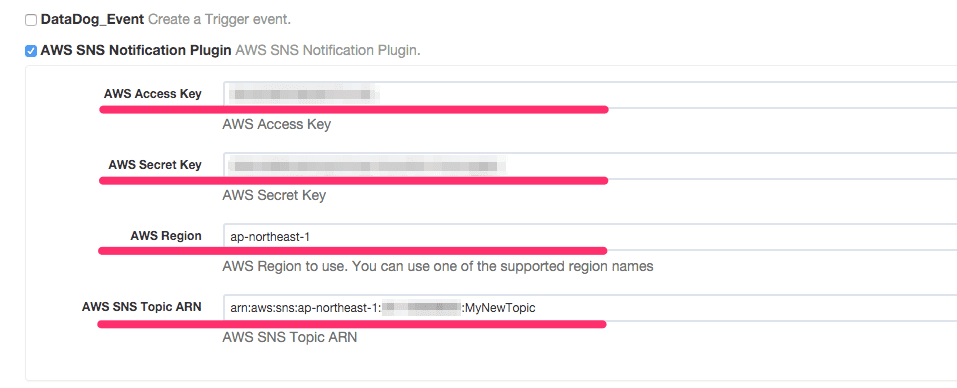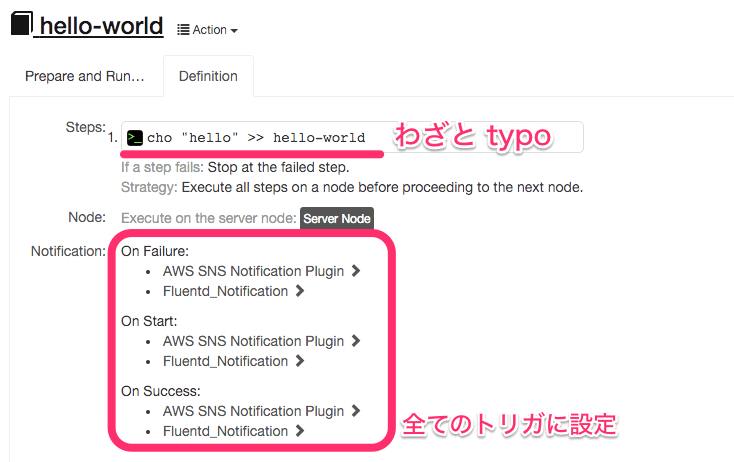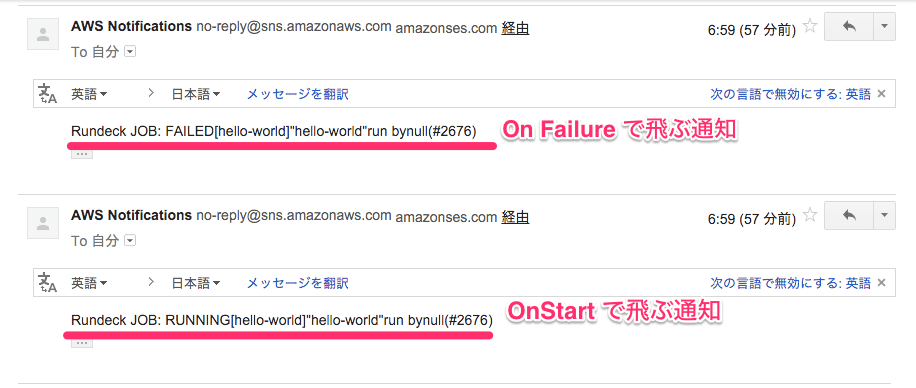おはげようございます。引き続き、きっと誰も使わないであろう Rundeck のプラグインづくり。
プラグイン二種盛り
AWS の SNS(Simple Notification Service) と Fluentd のインプット HTTP に通知するプラグインを作ってみた。
- inokappa/rundeck-aws_sns-notification-plugin · GitHub
- inokappa/rundeck-fluentd_http-notification-plugin · GitHub
見よう見真似。
それぞれのプラグインのデモっぽいの
rundeck-aws_sns-notification-plugin
Rundeck 上で通知の設定
以下のようにジョブの設定画面にてアクセスキー、シークレットアクセスキー、リージョン、Topic ARN を指定する。

デモなので全てのトリガ(On Failure / On Start / On Success)で通知するように設定した。

Subscribe 先に Email を指定した場合
以下のようにメールが届く。

rundeck-fluentd_http-notification-plugin
Rundeck 上で通知の設定
こちらもジョブの設定画面にてインプット HTTP のエンドポイント、ログに付けるタグの Prefix を指定する。

どちらかと言うと、通知というよりはログ的に使いたいので、全てのトリガ(On Failure / On Start / On Success)で通知するように設定した。

fluentd 側の設定
以下のように設定。
type http port 8888 bind 0.0.0.0 body_size_limit 32m keepalive_timeout 10s type stdout
設定したら以下のように Fluentd を起動する。
$ fluentd -c test.conf -l debug.log &
ジョブを実行すると…
以下のように debug.log ファイルにログとして出力される。
// OnStart 時に飛ぶ通知
2015-10-27 06:59:02 +0900 rundeck.notification.hello-world: {"execution_id":2676,"execution_href":"http://xxx.xxx.xx.xx:4440/project/hello-world/execution/follow/2676","execution_status":"RUNNING","execution_user":"admin","execution_dateStartedUnixtime":1445896741940,"execution_description":"","execution_argstring":null,"execution_project":"hello-world","execution_loglevel":"INFO","execution_failedNodeListString":null,"execution_failedNodeList":null,"execution_succeededNodeListString":null,"execution_succeededNodeList":null,"execution_nodestatus":null,"execution_dateEndedUnixtime":null,"execution_abortedby":null,"job_id":"fdf1cca5-e729-491b-a1fa-3d8fef373d46","job_href":"http://xxx.xxx.xx.xx:4440/project/hello-world/job/show/fdf1cca5-e729-491b-a1fa-3d8fef373d46","job_name":"hello-world","job_group":"","job_project":"hello-world","job_description":"","job_averageDuration":758}
// OnFailure 時に飛ぶ通知
2015-10-27 06:59:02 +0900 rundeck.notification.hello-world: {"execution_id":2676,"execution_href":"http://xxx.xxx.xx.xx:4440/project/hello-world/execution/follow/2676","execution_status":"FAILED","execution_user":"admin","execution_dateStartedUnixtime":1445896741940,"execution_description":"","execution_argstring":null,"execution_project":"hello-world","execution_loglevel":"INFO","execution_failedNodeListString":"localhost","execution_failedNodeList":["localhost"],"execution_succeededNodeListString":null,"execution_succeededNodeList":null,"execution_nodestatus":{"succeeded":0,"failed":1,"total":1},"execution_dateEndedUnixtime":1445896742912,"execution_abortedby":null,"job_id":"fdf1cca5-e729-491b-a1fa-3d8fef373d46","job_href":"http://xxx.xxx.xx.xx:4440/project/hello-world/job/show/fdf1cca5-e729-491b-a1fa-3d8fef373d46","job_name":"hello-world","job_group":"","job_project":"hello-world","job_description":"","job_averageDuration":758}
とりあえず、Rundeck Notification プラグインで取得出来るデータを全てダンプしてみた。
それぞれのプラグインを作る過程で得た知見
とりあえず列挙
具体的な内容については随時書いていく。
- AWS SDK for Java の簡単な使い方
- Gradle の簡単な使い方
AWS SDK for Javaの簡単な使い方
Credential
SDK で何かしようとすると避けては通れない認証周り。今回、rundeck-aws_sns-notification-plugin を作るにあたっては以下のコードが認証周りの定義になる。
(略)
import com.amazonaws.services.sns.AmazonSNSClient;
import com.amazonaws.auth.BasicAWSCredentials;
import com.amazonaws.regions.Region;
import com.amazonaws.regions.Regions;
(略)
public boolean postNotification(String trigger, Map executionData, Map config) {
BasicAWSCredentials awsCreds = new BasicAWSCredentials(aws_access_key, aws_secret_access_key);
AmazonSNSClient snsClient = new AmazonSNSClient(awsCreds);
snsClient.setRegion(Region.getRegion(Regions.fromName(aws_region)));
今回は Rundeck のジョブ設定画面から入力したアクセスキー(変数:aws_access_key)、シークレットアクセスキー(変数:aws_secret_access_key)を扱う為に com.amazonaws.auth.BasicAWSCredentials クラスを事前に import しておく。次にアクセスキーとシークレットアクセスキーを引数として BasicAWSCredentials からオブジェクトを生成、更にそのオブジェクトを引数として AmazonSNSClient クラスからオブジェクトを作成し認証の手続きが完了となる。
尚、この場合にはアクセスキーとシークレットアクセスキーを用いた認証のみ対応する実装になってしまっている為、IAM role や $HOME/.aws/credentials での認証には対応出来ない。(今後の改善点の一つ)
Gradle の簡単な使い方
Gradle とは
ザックリ言うと Groovy で書かれたビルドツールとのこと。build.gradle というファイルにビルドに必要な定義を記述して、以下のように実行すると jar ファイルや war ファイルを生成してくれる。個人的には make コマンドっぽい印象を受けている。
$ gradle build
gradle 自体のインストールは GVM というツールを利用してインストールするのが簡単だった。
build.gradle サンプル
rundeck-aws_sns-notification-plugin の build.gradle のサンプル。
version = '0.0.1'
defaultTasks 'clean','build'
apply plugin: 'java'
apply plugin: 'idea'
sourceCompatibility = 1.5
ext.rundeckPluginVersion= '1.1'
configurations{
pluginLibs
compile{
extendsFrom pluginLibs
}
}
repositories {
mavenLocal()
mavenCentral()
}
dependencies {
compile(group:'org.rundeck', name: 'rundeck-core', version: '2.6.1')
pluginLibs group: 'com.amazonaws', name: 'aws-java-sdk', version: '1.10.28'
}
task copyToLib(type: Copy) {
into "$buildDir/output/lib"
from configurations.pluginLibs
}
jar {
//include contents of output dir
from "$buildDir/output"
manifest {
attributes 'Rundeck-Plugin-Version': rundeckPluginVersion, 'Rundeck-Plugin-Archive': 'true', 'Rundeck-Plugin-Libs-Load-First':'false'
//create space-separated list of pluginLibs
def libList = configurations.pluginLibs.collect{'lib/'+it.name}.join(' ')
attributes 'Rundeck-Plugin-Classnames': 'com.inokara.rundeck.plugin.AwsSnsNotificationPlugin', 'Rundeck-Plugin-Libs': "${libList}"
}
}
jar.dependsOn(copyToLib)
task wrapper(type: Wrapper) {
gradleVersion = '1.8'
}
それぞれの設定については勉強中(纏まったら随時書いていく。)
全体を通して感じたこと、気付いたこと
- Java は怖くないし悪くない、Java が怖いという先入観と触らないのにアレコレ言うのが一番怖いし、悪い
- Groovy ならちょっとした JVM 上で動くスクリプトを割と簡単に作れそう(な気がするだけ)
- プログラミングの基礎が無いのは辛い
- ドキュメントをちゃんと読もう(但し、Java Doc の読み方が解らない…)
以上。





